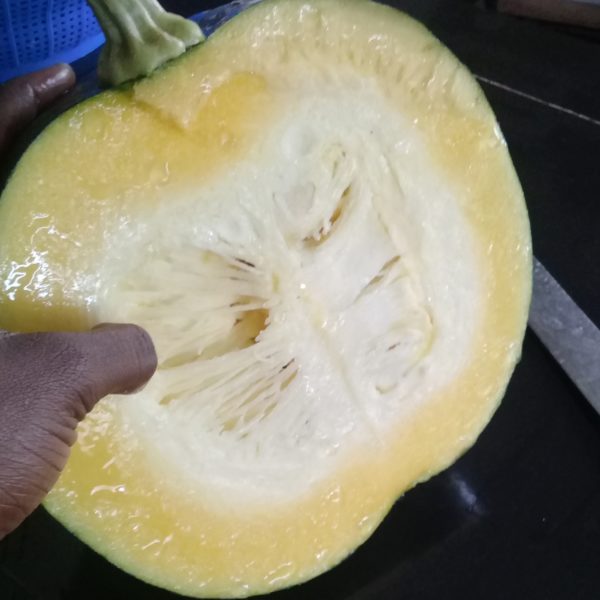Advertisment offer
Kabocha squash is a fruit that belongs to the group of plants known as Squash and it is a cultivar of the group, Cucurbita maxima. In the Western part of Nigeria, it is known as Elegede or Abeje while in the East, it is known as Anyu or Onugboro. In this post, you’ll be learning the best kabocha squash recipe.
Honestly, I am not certain that what we refer to as elegede or anyu in Nigeria is the kabocha squash. I was on this research for days and Kabocha is what I find closest to Elegede. However, this is contestable because some researchers reported that elegede belongs to the group Cucurbita pepo where kabocha belongs to Cucurbita maxima. But, from my own research and study of the various fruits in each cultivar (Cucurbita pepo and Cucurbita maxima), I could only find a fruit of close relation and characteristics with elegede in Cucurbita maxima and that is kabocha squash.
What are these characteristics of Elegede and kabocha squash?

The fruits have a hard exterior which is dark green in color with some white or yellow stripes and/ or dots which sometimes appear only faintly.
They have a peculiar yellow to bright orange colored flesh and somewhat white seeds.
Setting the debate aside, in this post, you’ll be learning a recipe made from elegede which also works well with kabocha squash. Somehow, the word kabocha sounds like I’m speaking in tongues but I’m not. Kabocha is a name of Japanese origin and sometimes, it is otherwise called Japanese squash.
Kabocha squash and elegede are of high nutritional importance. They richly contain vitamin A and C. They are characterized has a low-calorie foods and good sources of iron, copper, magnesium, B-vitamins, beta-carotene, dietary fiber, and various antioxidants.
The fruits are most notably known for their health benefits such as the ability to boost skin health, improve vision, strengthen the heart, aid in weight loss, and prevent certain cancers.
There is not one way to preparing or using these fruits in cuisines. They can be baked, made into porridge, used as a salad ingredient or used to make a paste or sauce.
The paste which can be enjoyed with yam is what I’ll be describing in the recipe below. So, read through how to prepare the best squash recipe, print out or bookmark and try in your kitchen.
Watch How to Prepare Kabocha/ Elegede Paste

| Prep Time | 40 min |
| Cook Time | 15 min |
| Passive Time | 1 hour |
| Servings |
people
|
- Squash/Pumpkin Kabocha/Elegede/Anyu
- Habanero pepper rodo (to taste)
- small onion (to taste)
- salt (to taste)
- seasoning cube (to taste)
- Palm oil
Ingredients
|

|
- Wash squash with salt and water and cut into two halves.
- Further cut into smaller sizes of about 3 to 4 pieces to form wedges which would ease cooking and handling.
- With the fleshy sides down, place the cut squash in a pot that is large enough to contain them. Add salt, water to reach the same level with the fruit wedges and cook for 35minutes. I used 1/4 tsp of salt for half a squash fruit.
- Remove water from the boiled fruit to enable you to easily peel them.
- Peel off the skin of the fruit, scoop out the innards and seeds and properly mash in a plate or bowl to form paste.
- Set mashed squash aside. Take some pepper and onions to blend for frying. For me, I only used 1/3rd of the mashed fruit so, I used one small onion and 3 small habanero. If you're frying all the mashed squash which is just half of the whole fruit, you will need about 6 of this habanero and a larger onion. Whichever quantity of onions and pepper you are using, wash them and blend till smooth.
- Put about 1 serving spoon of palm oil in a sauce pan and allow to heat. When hot, pour in the pepper, add salt and seasoning cube to taste. (For my 1/3 mashed squash, I used 1 chicken stock cube and 1/4 teaspoon of salt.) Add the seasoning and stir properly. Allow to fry for 2minutes.
- Add the mashed squash and stir well into the sauce. Stir continuously until the paste is even in color.
- Serve with chopped vegetables, boiled yam or omelette
Enjoying the best kabocha squash recipe with yam is what is often done in my hometown in Nigeria. However, I've met a Lebanese who had his kabosha squash paste with omelette. So, be flexible in enjoying this recipe!





